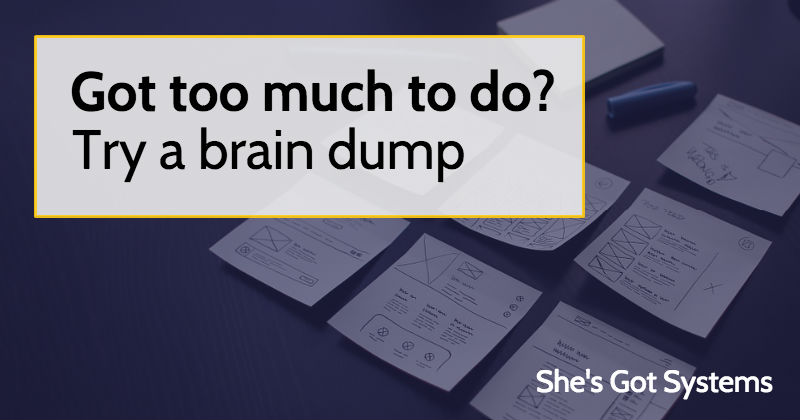Are you the type of creative entrepreneur who thrives on having 25 projects going simultaneously because that’s just how you like to work?
Welcome to the club. We would hold meetings but everyone is double booked anyway.
Having lots of ideas and projects and to do items is part of life but when it comes to “getting organized” or the less idealistic “not going crazy” there are few strategies I love more than a brain dump.
This is by no far an original idea, I first read about it in David Allen’s book Getting Things Done which is a lofty goal of a organized mind and business. The brain dump works like this:
1) Grab a ream of printer paper and a pen
2) Write down the first thing that comes to mind on the first sheet of paper, then set it aside
3) Repeat with new sheets of paper until your brain finishes thinking
Now, a bunch of people get all upset and decide that this is a waste of paper and “I’ll just use Post-it notes or note cards.” And then are surprised when that fails.
Use a full sheet of paper. It’s okay, you can re-use it or recycle when you’re done.
Personally I love using color paper which I buy by the ream in fun colors. I can’t explain why but my brain likes the variety. Don’t overcomplicate this by trying to use 5 different ink pens and a labeling system and don’t try to go in any order. Imagine someone tipping you upside down, shaking a bit, and all your ideas come pouring out on paper.
Okay, I’ve got a bunch of paper, now what?
Once your brain dump is “done” you can begin to sort and I promise that you’re probably not done because one idea is going to trigger another so keep those blanks sheets of paper handy.
{If you’re really adverse to using paper then look for recycled options. In college my University printed a cover sheet for every print job so I’d grab a stack of those. But really, a ream of paper is maybe $5 and if you’re creative then you know that making a list online isn’t the same.}
When I begin sorting I start with 2 piles: business and personal because it’s really hard to focus on filing that trademark when your brain keeps reminding you that it’s time to see the dentist.
When the personal papers and tasks are sorted out I’ll stack them separately to go through later but keep adding to the list.
Then you can work on the business related projects that have been floating around in your memory, bugging you at inopportune times like when you’re in the shower or just about to fall asleep. If you’d like you can continue to sort into groups. For me this looks like:
long term projects
client work to complete
marketing
products/programs
random stuff
but use whatever categories make sense for you.
Great, now that you’ve done a brain dump all is well, right? Not quite. To really put your mind at ease you have to take action. I know, I know, the list is the fun part. After all, if writing a list meant everything would happen magically I would make some fantastical lists.
Here are 4 strategies for tackling all those to dos:
1. Do the thing – David Allen suggests that you can immediately complete all tasks that take under 2 minutes but I tend to underestimate the time needed. Still, if there’s something on your list such as “take out the trash” or “put receipts in box for sorting” then go ahead and get some of those things off your list now. If you attempt to do internet related things then bring along a timer and set it for 5 minutes, if it can’t be finished in that time then use strategy #2
2. Schedule time – I hope you have a calendar because it’s about to get filled up! For every task that you need to work on select a time and date on your calendar and write it down. For example, you might not be able to call about an account because the business is closed but you can look up the number and business hours and add it to your calendar when they’re open. Then, make a note of this on the sheet of paper so you know what needs to happen next.
You don’t need to schedule enough time to finish the thing but it’s a good idea to identify the next step and take that action. For example, if you’re going to re-write your website pages then you don’t need to block off 3 days, start with 1 hour to copy the existing content into a doc and then more times later to work on each page.
3. Delete the thing – In the course of working through your piles of paper you might get to a point and think “do I really care?” and in that case you might want to ‘delete’ the task from your list. Whether it’s a project that you’re no longer passionate about, something where the deadline has passed or just simply not as important as you once thought, it’s okay to say no.
But what about those tasks you do want to complete, just not now?
4. Decide to do it later – I call this my “later list” and it’s a comprehensive accounting of those projects that stay on hand until I decide to begin working on them or delete them from the list. Maybe you have an old file cabinet that needs clearing out but can’t get it done this week. Add it to the later list so that a) your brain can stop worrying about it and b) you have a handy dandy reminder.
To make the later list actually work you’ll need to set reminders in your calendar. I try to look over my list every 30 days and always find a project I can delete, one I can start and usually one I did that month without taking it off the list.
The first challenge to getting more done and not going crazy is your brain dump so you know the Action Step this week will be to grab that paper and set aside at least 30 minutes to get out all the things lingering on your mind from an oil change for your car to new business cards.

 Calendar Systems
Calendar Systems How Flinging a Chicken Can Improve Your Systems
How Flinging a Chicken Can Improve Your Systems Systems are the Answer to your Struggles
Systems are the Answer to your Struggles